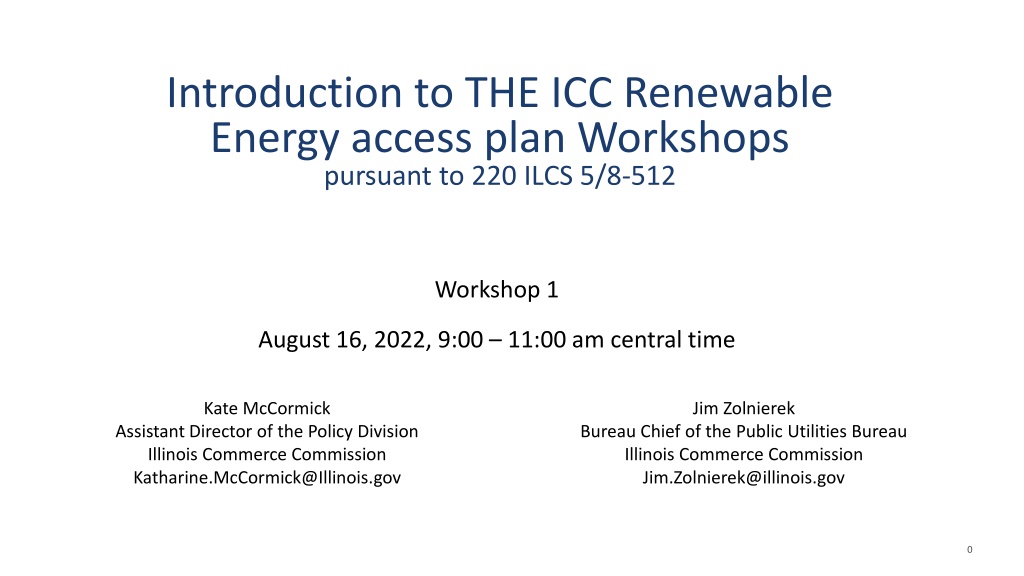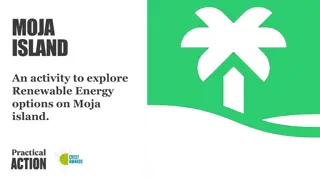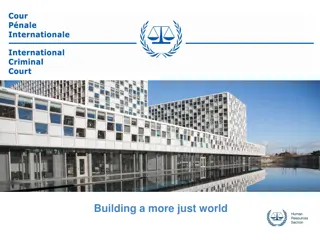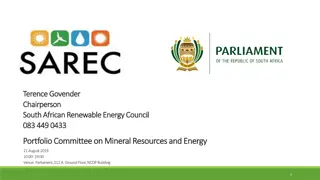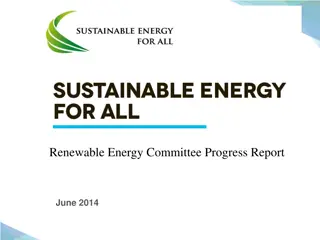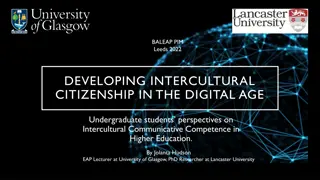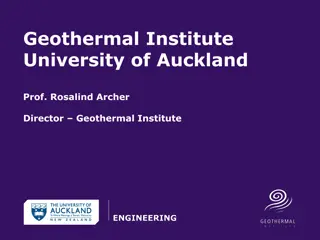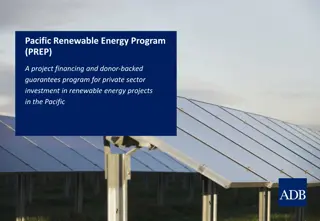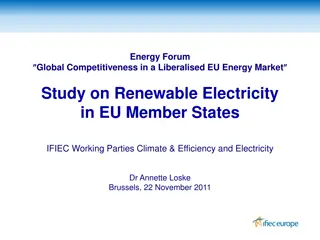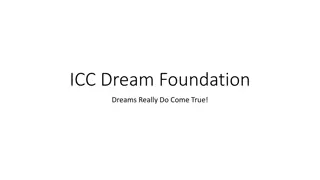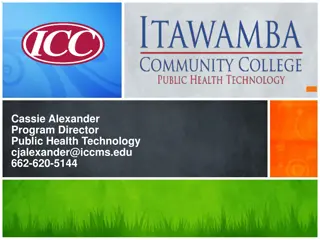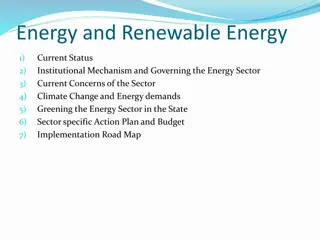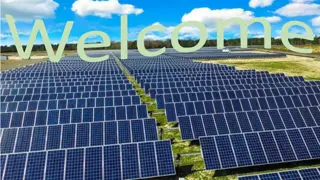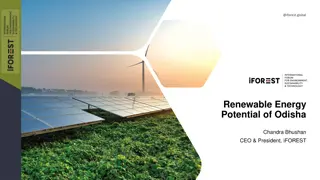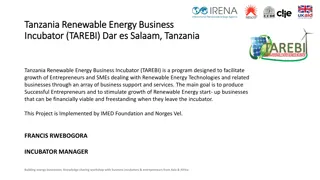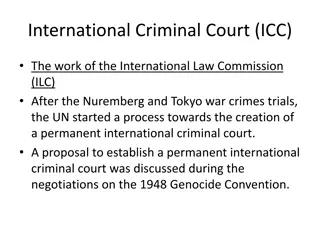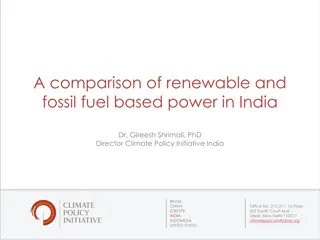ICC Renewable Energy Access Workshop Overview
The ICC Renewable Energy Access Plan workshops aim to discuss the implementation of CEJA (Climate and Equitable Jobs Act), focusing on clean energy goals and renewable energy transitions in Illinois. The workshops provide insights, analysis, and opportunities for stakeholder feedback to ensure a just and equitable transition to 100% clean energy by 2050.
Download Presentation

Please find below an Image/Link to download the presentation.
The content on the website is provided AS IS for your information and personal use only. It may not be sold, licensed, or shared on other websites without obtaining consent from the author. Download presentation by click this link. If you encounter any issues during the download, it is possible that the publisher has removed the file from their server.
E N D
Presentation Transcript
Introduction to THE ICC Renewable Energy access plan Workshops pursuant to 220 ILCS 5/8-512 Workshop 1 August 16, 2022, 9:00 11:00 am central time Kate McCormick Jim Zolnierek Assistant Director of the Policy Division Illinois Commerce Commission Katharine.McCormick@Illinois.gov Bureau Chief of the Public Utilities Bureau Illinois Commerce Commission Jim.Zolnierek@illinois.gov 0
Disclaimer This slide deck and its contents are intended for informational and discussion purposes only and do not represent a legal interpretation or statement of policy by the ICC or its Staff. Views and opinions expressed by ICC personnel during the workshop are their own and do not necessarily reflect the views of the ICC. 1
Administrative Items In the interest of time, we will forgo formal introductions of the participants today. In lieu of introductions, please type your name, role, and organization into the WebEx chat. Mute yourself when not speaking The Webex will allow for verbalquestions or questions inserted in the chat We will pause at regular intervals for questions Please share your name and organization when you speak If comfortable, share video when commenting 2
Agenda Summary of CEJA Goals, Introduction to the REAP (ICC Staff) Overview of Initial Draft REAP and analysis in progress (The Brattle Group) Initial stakeholder and public comment on CEJA goals, draft report, and posted questions Open Discussion Next Steps 1. 2. 3. 4. 5. 3
Climate and Equitable Jobs Act (CEJA) CEJA Enactment - Public Act 102-0662, commonly referred to as the Climate and Equitable Jobs Act or CEJA, was enacted by the General Assembly with an effective date of September 15, 2021. CEJA can be found at https://www.ilga.gov/legislation/publicacts/102/PDF/102-0662.pdf. CEJA Implementation Webpage: The Illinois Commerce Commission s implementation activities related to CEJA can be found at: https://www.icc.illinois.gov/programs/climate-and-equitable-jobs-act- implementation. 4
CEJA Goals Clean Energy -- The General Assembly finds and declares it is the policy of this State to rapidly transition to 100% clean energy by 2050. CEJA Enrolled at 249. Renewable Energy -- Existing transmission infrastructure may constrain the State's achievement of 100% renewable energy by 2050, the accelerated adoption of electric vehicles in a just and equitable way, and electrification of additional sectors of the Illinois economy. CEJA Enrolled at 682. The General Assembly finds that, as part of putting Illinois on a path to 100% renewable energy, the State of Illinois should ensure a just transition to that goal CEJA Enrolled at 111. 5
CEJA Goals (Continued) Electrification It is the intent of the General Assembly to increase access to electrification for all consumers CEJA Enrolled at 192. Illinois should increase the adoption of electric vehicles in the State to 1,000,000 by 2030. CEJA Enrolled at 192 Beginning in 2022, an electric utility may offer and promote measures that electrify space heating, water heating, cooling, drying, cooking, industrial processes, and other building and industrial end uses CEJA Enrolled at 600. Equity and Opportunity -- It is in the public policy interest of the State to ensure that Illinois residents from communities disproportionately impacted by climate change, communities facing coal plant or coal mine closures, and economically disadvantaged communities and individuals experiencing barriers to employment have access to State programs and good jobs and career opportunities in growing sectors of the State economy. CEJA Enrolled at 249. 6
CEJA Goals (Continued) Reliability and Resilience The provisions of this Act also will support the reliability of the bulk power grid in this State by incentivizing and supporting installation of new generating facilities and energy storage facilities at locations on the grid where synchronous generation was formerly located. CEJA Enrolled at 166. The General Assembly finds and declares that (1) Energy storage systems provide opportunities to (F) enhance the resilience and reliability of the electric grid; . CEJA Enrolled at 908. Affordability -- The breadth of this framework should revise existing utility regulations to position Illinois electric utilities to effectively and efficiently achieve current and anticipated future energy needs of this State, while ensuring affordability for consumers. 7
Initial REAP Timetable Development and Adoption of the REAP -- CEJA added to the Illinois Public Utilities Act, new Section 8-512, which requires the Commission, no later than December 31, 2022, to open an investigation to develop and adopt a renewable energy access plan (REAP). Draft Report -- Prior to opening the investigation, the Act requires the Commission to publish a draft REAP. Comment Period Following the publication of the first draft of the REAP, the Commission is to provide for a 120- day open public comment period. Final Draft Report - The final draft report is to be published within 90 days of the end of the public comment period. Following this, the investigation referred to above will be initiated. Biennial REAP Updates No later than December 31, 2025, and every other year thereafter, the Commission is to open an investigation to develop and adopt an updated renewable energy access plan. 8
REAP Requirements REAP Zones The REAP is to designate renewable energy access plan zones throughout this State in areas in which renewable energy resources and suitable land areas are sufficient for developing generating capacity from renewable energy technologies. Transmission Plan The REAP is to develop a plan to achieve transmission capacity necessary to deliver the electric output from renewable energy technologies in the renewable energy access plan zones to customers in Illinois and other states in a manner that is most beneficial and cost-effective to customers. Investment in Renewables The REAP is to use this State's position as an electricity generation and power transmission hub to create new investment in this State's renewable energy resources. 9
REAP Requirements (CONTINUED) Achievement of RPS Goals The REAP is to consider programs, policies, and electric transmission projects that can be adopted within this State that promote the cost- effective delivery of power from renewable energy resources interconnected to the bulk electric system to meet the renewable portfolio standard targets under subsection (c) of Section 1-75 of the Illinois Power Agency Act. Improve RTO Planning The REAP is to consider proposals to improve regional transmission organizations' regional and interregional system planning processes, especially proposals that reduce costs and emissions, create jobs, and increase State and regional power system reliability to prevent high-cost outages that can endanger lives, and analyze of how those proposals would improve reliability and cost-effective delivery of electricity in Illinois and the region. 10
REAP Requirements (CONTINUED) Cost Effectively Achieve Goals The REAP is to make findings and policy recommendations based on technical and policy analysis regarding locations of renewable energy access plan zones and the transmission system developments needed to cost-effectively achieve the public policy goals identified herein. Findings and Conclusions The REAP will present the Commission's conclusions and proposed recommendations based on its analysis and use the findings and policy recommendations to determine actions that the Commission should take. 11
First Draft: Illinois Renewable Energy Access Plan WORKSHOP 1: OVERVIEW OF THE FIRST DRAFT REAP PREPARED FOR Illinois Commerce Commission PREPARED BY Illinois Commerce Commission Staff The Brattle Group Great Lakes Engineering AUGUST 16, 2022
NOTICES FIRST DRAFT RENEWABLE ENERGY ACCESS PLAN Materials related to the Illinois Renewable Energy Access Plan (REAP), including the first draft of the REAP discussed in this presentation, information related to public workshops, and comments are available on the ICC REAP website. The first draft of the Illinois REAP was co-authored by staff of the Illinois Commerce Commission (ICC) and The Brattle Group. Consultants from Great Lakes Engineering served as contributing authors focused on land use and renewable energy access zones. The report has been prepared with and for ICC staff but is not an endorsement by the ICC commissioners. CONTRIBUTING AUTHORS Staff of the Illinois Commerce Commission Katharine McCormick, James Zolnierek, Torsten Clausen, Parth Patel, Zachary Callen, Bill VanderLaan, Larry Borum III The Brattle Group Kathleen Spees, Samuel A. Newell, Johannes P. Pfeifenberger, Joe DeLosa III, Linquan Bai, Ragini Sreenath, Evan Bennett, Ethan Snyder Great Lakes Engineering Donald Peterson, Brian Muzingo Ewalt brattle.com | 13
Overview: First draft of Illinois Renewable Energy Access Plan (REAP) STRATEGIC ELEMENT 1: Renewable electricity supply needs in Illinois are large and subject to high uncertainty, ranging from 64 TWh to 450 TWh by 2050 The REAP should provide a comprehensive plan for the State of Illinois to meet its climate and clean energy goals equitably, reliably, and cost-effectively. STRATEGIC ELEMENT 2: Clarification of certain policy instruments and enforcement authorities will enable more accurate determination of the scale of clean energy needed and the reforms necessary to implement CEJA policies STRATEGIC ELEMENT 3: Identification of renewable energy access zones should enable a repeatable process allowing Illinois to provide regular input to RTO transmission planning and access First draft of the REAP identified several strategic elements. STRATEGIC ELEMENT 4: Existing transmission infrastructure should be optimized to support renewable resource deployment STRATEGIC ELEMENT 5: Proactive planning of new transmission with consideration of public policy needs is superior to relying on interconnection processes to reach CEJA s goals STRATEGIC ELEMENT 6: RTO markets will require enhancements to support effective, reliable, and affordable implementation of CEJA policies brattle.com | 14
STRATEGIC ELEMENT 1: Renewable electricity supply needs in Illinois are large and subject to high uncertainty, ranging from 64 TWh to 450 TWh by 2050
Pace of required renewable deployment is large and subject to substantial uncertainties OUTLOOK FOR ILLINOIS CLEAN ELECTRICITY SUPPLY NEEDS The 100% clean energy economy goal in 2050 could require ~152 450 TWh of clean supply, depending on the scale of electrification The 50% RPS for ComEd, Ameren and a portion of MidAmerican customers will require a minimum of ~64 TWh of renewable generation by 2040 brattle.com | 16
STRATEGIC ELEMENT 2: Clarification of certain policy instruments and enforcement authorities will enable more accurate determination of clean energy needs and the reforms necessary to implement CEJA policies
Innovative policy solutions may be needed to clarify scale of renewable deployment and guide cost-effective, reliable transition Feedback requested: What policy solutions, responsible entities, and implementation mechanisms will address identified challenges? Policies Opportunities for Clarification and Policy Innovation Establish an economy- wide energy decarbonization strategy Identify responsible entities, interim targets, and enforcement mechanisms within transportation and natural gas sectors will improve our ability to forecast electrification-driven demand growth that must be served by clean electricity Identify innovative mechanisms to achieve 100% clean electricity goal Clarification of 100% clean electricity goals as applicable beyond the 50% RPS mandate and as applicable to non-RPS-obligated consumers Clarify eligibility status and policy instruments for relying on a balanced mix of renewables, nuclear (after support payments expire), batteries, distributed resources, imported clean supply, and export of clean energy surpluses so as to support cost-effective, reliable fleet transition Refine GHG accounting methods Clarify Illinois accounting and treatment of Scope 2 electricity emissions from out-of-state fossil resources that operate to serve Illinois consumers, to ensure any GHG emissions embedded in imports will be offset by clean electricity exports in the eventual demonstration of a 100% GHG-free electricity mix Align RTO market reforms and Illinois policy mechanisms Identify strategies to mitigate GHG emissions leakage Develop a coordinated set of incentives to drive a balance between system reliability needs (as quantified primarily through RTO markets) and policy requirements (as established under Illinois policy) brattle.com | 18
STRATEGIC ELEMENT 3: Identification of renewable energy access zones should enable a repeatable process allowing Illinois to provide regular input to RTO transmission planning and access
Purpose and use of REAP zones will drive analysis Initial Key Insight: Illinois appears to have many possible locations with sufficient resource potential and land usability, so development can occur where most efficient transmission-wise; a great opportunity if the processes facilitate that Feedback Requested: How can or should renewable energy zones be used by RTOs, state agencies, developers, or others? Initial concept aims to identify two levels of REAP Zones: Level 1 Zones: Locations where substantial volumes of renewables can be integrated with existing transmission or modest upgrades (considering anticipated fossil retirements). Illinois will seek partnership with RTOs to expedite and streamline interconnection processes and deployment in these zones What reforms to local or state-wide permitting processes are needed? Are the criteria identified in the first draft of the REAP appropriate to designate zones (next slide)? What other criteria should be considered? Level 2 Zones: Locations that demonstrate a high suitability for future renewable development, to be considered in comprehensive RTO transmission planning processes ICC is seeking strategic partnership with RTOs to reform processes sufficiently to meaningfully utilize the identified REAP zones; historical practice and process do not offer an obvious pathway to facilitating the large-scale deployment required under CEJA brattle.com | 20
Assessing suitability for REAP zones Illinois has fairly broadly distributed wind and solar resource potential across the state. We seek input in the proper strategy for REAP zone identification, whether to aim for the largest potential areas or focus resources in smaller regions, criteria for zone selection, and methods for prioritizing criteria. WIND AND SOLAR RESOURCE POTENTIAL Feedback requested: Potential criteria and metrics to inform zones, such as: Equity: Equity measures within CEJA will focus a portion of development efforts through funding mechanisms, coal-to-solar program, and timing of fossil emissions phase outs (which will create need and opportunity for renewable development). Renewable zones may further consider: Environmental Justice Communities Equity Investment Eligible Communities Energy Transition Communities Enterprise Zones Transmission availability: Locations with transmission headroom, including headroom that will be created by fossil retirements Indicators of developer interest: As measured by interconnection requests, prior development, announced projects, or other metrics Land use, zoning, permitting: Predominant land uses, ordinances involving land-use based prohibitions for renewable development, as well as setbacks specified, will affect total area available for new resource development Source and Notes: US Energy Information Administration GIS map. brattle.com | 21
STRATEGIC ELEMENT 4: Existing transmission infrastructure should be optimized to support renewable resource deployment STRATEGIC ELEMENT 5: Proactive planning of new transmission with consideration of public policy needs is superior to relying on interconnection processes to reach CEJA s goals
Foundational interconnection processes reforms will be needed to match pace of required energy transition PJM INTERCONNECTION QUEUE OUTLOOK Initial evidence suggests interconnection is the single greatest barrier to large-scale renewable deployment for several reasons: Processes too slow to match pace of policy requirements; likely only partially addressed by proposed reforms Interconnection triggers network upgrades on a piecemeal basis resulting in excess costs compared to coordinated planning for policy needs (particularly in PJM) Lack of clarity and efficient process to utilize locations with greatest headroom Lack of process to coordinate fossil exit with renewable entry Source: RTEP book 1 at 7; see also PJM Queue Status Update. REAP will set vision for foundational reforms, and will require strategic partnership with RTOs to identify both long-term and interim solutions. Options to consider: MISO INTERCONNECTION QUEUE OUTLOOK First-best, long-term reforms: more proactive transmission planning; foundational reforms to interconnection processes, such as connect-and-manage; use of level 1 REAP zones to pre-approve development on a first-come, first-serve basis; revise energy and capacity injection rights processes to better coordinate renewable entry and fossil exit (that may not proceed at identical times); more use of new technologies to get the most out of the existing transmission system Interim solutions: maximize participation in existing planning processes; explore whether PJM state agreement approach (SAA) process offers opportunity Feedback Requested: What solutions should be pursued, and through what venues should Illinois agencies and RTOs aim to implement them? Source: MISO 2020 Interconnection Queue Outlook at 7. brattle.com | 23
MISOs transmission planning process offers robust framework for meeting policy needs, with incremental reforms MISO S TRANSMISSION PLANNING PROCESS CONSIDERS POLICY NEEDS AND OTHER SYSTEM UNCERTAINTIES Several features of MISO s transmission planning processes are well equipped to proactively plan for Illinois policy needs: Scenario-based transmission planning approach (alternative resource mix Futures and extreme weather events considered) Full incorporation of policy needs (requires active participation of Illinois agency representatives in scenario development) Multi-value project (MVP) approach identifies portfolio of transmission needs considering reliability, economic, and policy drivers New elements of the MISO planning process will be needed to address context of CEJA. ICC will work with MISO staff to identify whether current processes are sufficiently flexible to examine: MULTI-VALUE PROJECTS ARE SELECTED IF ECONOMIC, RELIABILITY & POLICY BENEFITS EXCEED COSTS Implications of fossil phase-out: impacts for system reliability, security, and transmission needed to support exit; proactive identification of new transmission security threats and how to address them Renewable headroom outlook in transition: considering both the existing system and headroom created by fossil exit (without excess transmission development as renewables and fossil resources co-exist in transition) REAP zones: incorporate identified level 1 and level 2 REAP zones into interconnection and planning processes brattle.com | 24 Sources: MTEP 21 Addendum, Executive Summary, at 5; and MISO Futures Presentation at 6 .
PJMs transmission planning process requires substantial reforms to adequately plan for Illinois policy needs PJM STATE POLICIES: INCORPORATED INTO INFORMATIVE STUDIES, BUT NET YET IN TRANSMISSION PLANNING Under present practice, PJM s planning processes do not proactively consider public policy as a driver for new transmission (except under SAA). Challenges: Excess reliance on individual resource interconnection requests to drive planning results in excess total cost, excess costs to individual interconnecting resources that trigger a large network upgrade requirement, and delays associated with queue processes Lack of scenario-based, multi-value project approach that accounts for long-term system needs such as used in MISO Need expanded study of Illinois specific needs in CEJA, accounting for fossil phase-out, projections of renewable headroom, and achievement of total clean electricity goals REAP will seek strategic partnership with PJM RTO staff to determine how planning processes can be enhanced to fully incorporate policy needs both under long-term reforms and interim solutions, such as: Maximizing opportunity in the ongoing FERC rulemaking to accomplish foundational reforms and incorporate scenario-based, MVP planning processes that account for policy (see PJM responses) Work with PJM staff to refine and continue analysis begun in PJM s recent IL REAP Retirement Study and PJM Offshore Wind Study (OSW) Phase 1, and determine how the findings can be integrated to long-term transmission planning (currently these are informative only) Exploring whether the State Agreement Approach (SAA) is flexible enough to address Illinois context so as to accommodate and coordinate both large-scale fossil retirement and overlapping large-scale renewable entry See: PJM Offshore Wind Study Phase 1. brattle.com | 25
STRATEGIC ELEMENT 6: RTO markets will require enhancements to support effective, reliable, and affordable implementation of CEJA policies
Role of RTO markets in supporting CEJA implementation Initial draft of the REAP identifies critical roles that RTOs and the markets they operate will need to play to support achievement of policy goals: The REAP will seek to engage with MISO and PJM on an ongoing basis as strategic partners to support reliable and cost- effective clean energy transition Provide informational and data support ICC and other Illinois agencies to inform decision-making Ensure reliability on all timeframes, with a proactive stance to maintain reliability without leaning on fossil resource extensions or dispatch above GHG allowance limits Support to identify, analyze and implement market design enhancements to align dispatch and investment signals with CEJA policy requirements Maximize opportunities for Illinois to cost-effectively coordinate clean energy transition with states and consumers across both regions via mutually beneficial trade and balancing services brattle.com | 27
Initial assessment of opportunities to coordinate RTO market incentives with Illinois policy requirements Issue Opportunities for Enhanced RTO Support Development of accurate Scope 2 emissions accounting methods in alignment with REAP recommendations Providing granular system GHG data Determining strategies to ensure reductions to in-state emissions within Illinois will not by replaced by increases in emissions from out-of-state fossil resources Quantifying and mitigating GHG leakage as fossil-fired generation is phased out Development of mechanisms to support steady increases in the reliance on clean capacity resources to replace retiring fossil, with accurate accounting of decline in capacity value from mandated fossil unit emission reductions and proactively preparing for capacity transition Ensuring availability of sufficient capacity as fossil-fired generation is phased out Addressing insufficiencies in current incentive mechanisms to enable markets to support capacity investments and maintain reliability Addressing underlying concerns in MISO s resource adequacy construct Enhancement of RTO ancillary service markets and operational capabilities to manage an entirely clean electricity system Proactively improving both RTOs capability to rely increasingly, and eventually exclusively, on clean resources Developing market platform, such as has been requested by Illinois and other PJM states, to facilitate state agency and private consumer procurements for: (a) cost-effective retention of nuclear supply after support expires; (b) supporting clean capacity investment and retention throughout fossil emissions phase out; (c) providing a procurement option or platform for RPS- obligated consumers to meet up to 100% clean electricity mandates; and (d) providing a procurement option or platform for non-RPS-obligated consumers to meet clean electricity goals Providing a platform for the procurement of cost-effective clean energy resources brattle.com | 28
Stakeholder Input to Inform the 2nd Draft of the REAP The first draft of the REAP, workshop information, and updates can be found here. Comments on the REAP can be provided formally, as presentations in the scheduled workshops, or informally. Submit comments to Katharine.McCormick@illinois.gov or Jim.Zolnierek@Illinois.gov. 2022 2023 October 6th September 12th December August 16th (Today) Workshop 1: Overview of 1st Draft REAP November 9th July 12th 2nd Draft REAP published; initiate ICC investigation Workshop 3: Agenda TBA End of Comment Period for first Draft Workshop 2: Discussion with the RTOs 1st Draft REAP published ICC Investigation To review and adopt the REAP 120 Day Comment Period Comments submitted at any time, but input to RTO, ICC, and consultant ongoing analytical work requested before September 12 if possible brattle.com | 30
